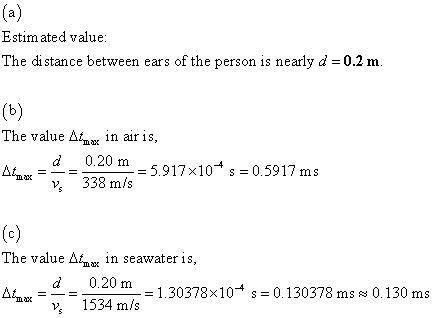
When you hear a noise, you usually know the direction from which it came even if you cannot see the source. This ability is partly because you have hearing in two ears. Imagine a noise from a source that is directly to your right. The sound reaches your right ear before it reaches your left ear. Your brain interprets this extra travel time (Δt) to your left ear and identifies the source as being directly to your right. In this simple model, the extra travel time is maximal for a source located directly to your right or left (Δt = Δtmax). A source directly behind or in front of you has equal travel time to each ear, so Δt = 0. Sources at other locations have intermediate extra travel times (0 ≤ Δt ≤ Δtmax). Assume a source is directly to your right.(a) Estimate the distance between a person's ears. (they gave us the answer of .2... apparently the program is messed up and we have to use .2(b) If the speed of sound in air at room temperature is vs = 338 m/s, find Δtmax. (Use your estimate.)
(c) Find Δtmax if instead you and the source are in seawater at the same temperature, where vs = 1534 m/s. (Use your estimate.)

Answers: 2


Another question on Physics

Physics, 22.06.2019 20:40
Abasketball star covers 2.65 m horizontally in a jump to dunk the ball. his motion through space can be modeled precisely as that of a particle at his center of mass. his center of mass is at elevation 1.02 m when he leaves the floor. it reaches a maximum height of 1.90 m above the floor and is at elevation 0.910 m when he touches down again. (a) determine his time of flight (his "hang time"). (b) determine his horizontal velocity at the instant of takeoff. (c) determine his vertical velocity at the instant of takeoff. (d) determine his takeoff angle. (e) for comparison, determine the hang time of a whitetail deer making a jump with center-of-mass elevations yi = 1.20 m, ymax = 2.45 m, and yf = 0.750 m.
Answers: 1

Physics, 22.06.2019 23:30
Newton's law of cooling states that the rate of change in the temperature t(t) of a body is proportional to the difference between the temperature of the medium m(t) and the temperature of the body. that is, startfraction dt over dt endfraction equals upper k left bracket upper m left parenthesis t right parenthesis minus upper t left parenthesis t right parenthesis right bracket , where k is a constant. let kequals0.04 left parenthesis min right parenthesis superscript negative 1 and the temperature of the medium be constant, m(t) font size decreased by 3 equivalent font size decreased by 3 294 kelvins. if the body is initially at 369 kelvins, use euler's method with hequals0.1 min to approximate the temperature of the body after (a) 30 minutes and (b) 60 minutes.
Answers: 2

Physics, 23.06.2019 00:00
Why should the wavelength scale of spectroscope be calibrated
Answers: 2

You know the right answer?
When you hear a noise, you usually know the direction from which it came even if you cannot see the...
Questions



Mathematics, 31.01.2020 11:05

History, 31.01.2020 11:05

Mathematics, 31.01.2020 11:05

Mathematics, 31.01.2020 11:06

Biology, 31.01.2020 11:06


Mathematics, 31.01.2020 11:06


Business, 31.01.2020 11:06


World Languages, 31.01.2020 11:06

Mathematics, 31.01.2020 11:06

Mathematics, 31.01.2020 11:06

Mathematics, 31.01.2020 11:06

Social Studies, 31.01.2020 11:06

Mathematics, 31.01.2020 11:06

Mathematics, 31.01.2020 11:06

Mathematics, 31.01.2020 11:06




